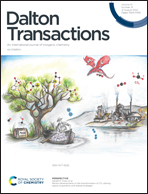Cleaner and stronger: how 8-quinolinolate facilitates formation of Co(iii)–thiolate from Co(ii)–disulfide complexes†
Abstract
The formation of Co(III)–thiolate complexes from Co(II)–disulfide complexes using the anionic ligand 8-quinolinolate (quin−) has been studied experimentally and quantum chemically. Two Co(II)–disulfide complexes [Co2(LxSSLx)(Cl)4] (x = 1 or 2; L1SSL1 = 2,2′-disulfanediylbis(N,N-bis(pyridin-2-ylmethyl)ethan-1-amine; L2SSL2 = 2,2′-disulfanedylbis (N-((6-methylpyridin-2-yl)methyl)-N-(pyridin-2-ylmethyl) ethan-1-amine) have been successfully converted with high yield to their corresponding Co(III)–thiolate complexes upon addition of the ligand 8-quinolinolate. Using density functional theory (DFT) computations the d-orbital splitting energies of the cobalt–thiolate compounds [Co(L1S)(quin)]+ and [Co(L2S)(quin)]+ were estimated to be 3.10 eV and 3.07 eV, indicating a slightly smaller ligand-field strength of ligand L2SSL2 than of L1SSL1. Furthermore, the orientation of the quin− ligand in the thiolate compounds determines the stability of the thiolate complex. DFT computations show that the thiolate structure benefits from more electrostatic attraction when the oxygen atom of the quin− ligand is positioned trans to the sulfur atom of the [Co(L1S)]2+ fragment. Quin− is the first auxiliary ligand with which it appeared possible to induce the redox-conversion reaction in cobalt(II) compounds of the relatively weak-field ligand L2SSL2.



 Please wait while we load your content...
Please wait while we load your content...